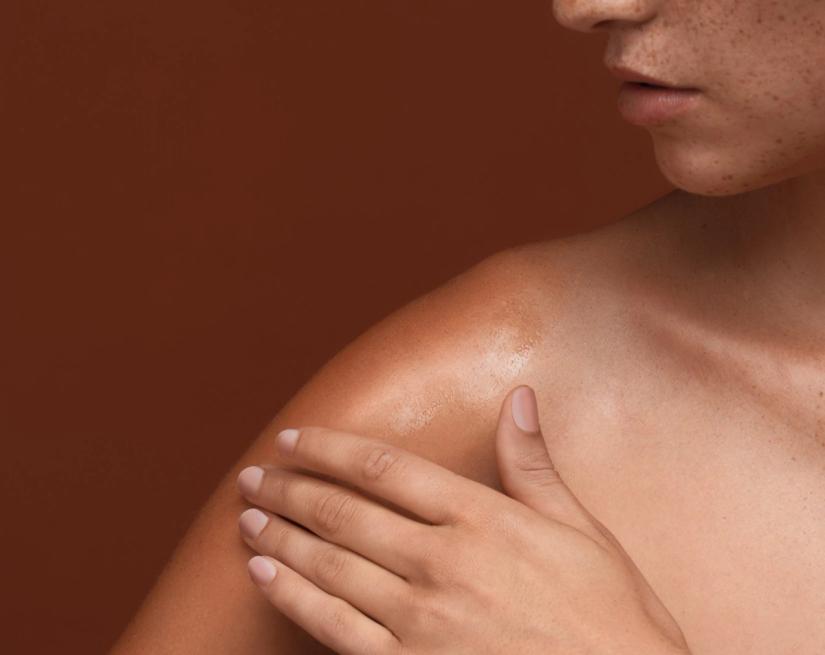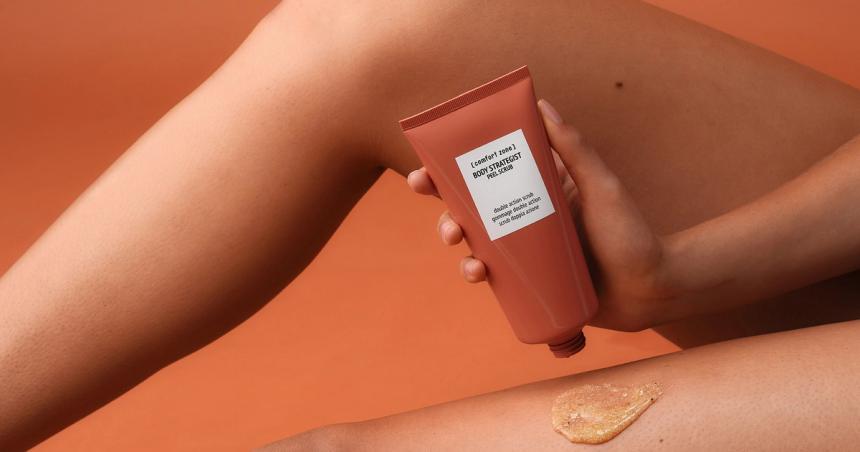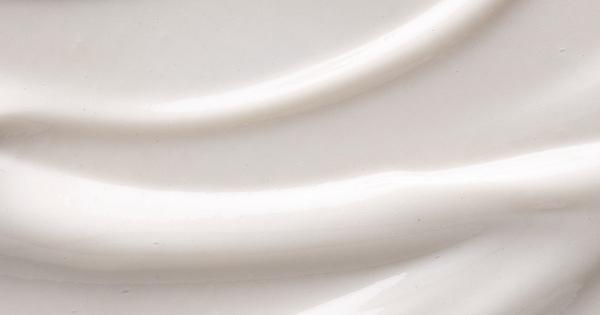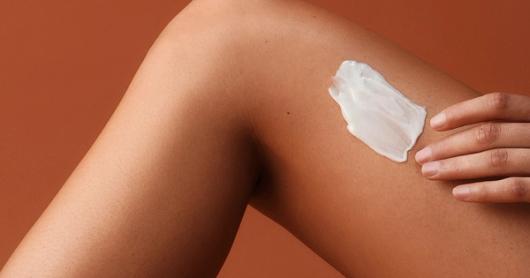Body Strategist D-Age Cream
Firming nourishing cream
skin care
Eve Mérinville | Corporate RD Excellence & SC RD and Innovation Director
10 min read

Oftentimes, we criticize our bodies with unrealistic beauty ideals in mind. Instead, we should direct our energy toward appreciating what our bodies do for us and taking care of the skin that protects them. With just a few daily steps, implementing a personalized body skin care routine can promote your confidence and skin health. Consistency is key to creating lasting results.
The skin is the largest organ in the human body, and every day it connects us with the outside world. It also performs a fundamental barrier function, protecting us, like a kind of armor, from the effects of the environment.
The skin care world has always focused heavily on the care and hydration of facial skin. However, we should not forget to actively support our body skin as well, which too often takes a back seat or is treated with products that do not fully respect its nature. The skin of the body is generally better protected from the damaging effects of the sun and pollution than the hands, face, and neck, regions that being exposed all the time tend to dry out from exposure, develop blemishes, and age faster.
This difference, has led many people to mistakenly hold the idea that we can care for the skin in these areas and neglect the skin on the rest of the body. Rather, all of our body skin requires daily care and attention, which can be provided to it through the development of a proper body skin care routine, with the goal of keeping it toned, hydrated, and smooth at all times.
Although the skin on the whole body has the same scaffold consisting of three overlapping layers— epidermis, dermis, and hypodermis—the skin is significantly different depending on where it is on the body. For example, the skin on our face has special and specific characteristics that are not found on any other region of the body. Its delicate structure means that there are products on the market specially designed for the facial skin that would not provide the same results elsewhere on the body. The main differences between facial and body skin are:
| FACIAL SKINCARE | BODY SKINCARE | ||
| CELLULAR SIZE | The corneocytes, the cells that make up the outermost layer of our skin, at the level of the face, are found to be smaller in size than those that make up the stratum corneum of other regions of the body. | The corneocytes, the cells that make up the outermost layer of our skin, at the body level, are found to be bigger in size than those that make up the stratum corneum of other regions of the face. | |
| THICKNESS | The skin of our face, with its smaller skin cells and fewer cell layers at the level of the stratum corneum, is much thinner than the skin of the body, so it tends to get drier than the skin on our bodies. | The skin of our body , with its biger skin cells and multiple cell layers at the level of the stratum corneum, is much thicker than the skin of the face, so it tends to get less dry than the skin on our face. | |
| CELL RENEWAL RATE | Skin cell turnover in our face is faster than skin cell turnover in our body. | Skin cell turnover in our body takes longer than skin cell turnover in the face as the cells must move from deeper to more superficial layers. | |
| TRANSEPIDERMAL WATER LOSS (TEWL) | Each region of the skin has a specific TEWL value that indicates the amount of water that is lost from the tissue in the form of water vapor. The skin of our face is characterized by a higher TEWL value than that at the level of our body. | Contrary to face skin, the skin of our body is characterized by a lower TEWL value than that at the level of the face. | |
| DENSITY OF SEBACEOUS GLANDS | In facial skin, there is a much higher concentration of sebaceous glands than in the rest of the body, which also tends to dry out much more quickly for this reason. | In body skin, there is a much smaller concentration of sebaceous glands than in the face, which also tends to dry less quickly for this reason. | |
| NUMBER OF HAIR FOLLICLES | Hair follicles are structures that contain the cells from which hair is formed. On the face, there is less hair development than there is on the body. However, the concentration of hair follicles is higher at the facial level. | Hair follicles are structures that contain the cells from which hair is formed. On the body, there is greater hair development than there is on the face. However, the concentration of hair follicles is higher at the facial level. |
All these factors help us to understand that the skin on the body and the skin on the face are very different from each other and should be cared for accordingly. The skin care routine we use for the face cannot be the same as the one we use on the body. The skin on the body needs specific products and attention through an effective body skin care routine.
To attain soft, firm, and toned skin, there are a few simple steps that can drastically improve the body's skin health when followed properly. In order for these steps to be effective it is essential that they are carried out daily, consistently, and in the correct order to create noticeable results.
The first step in turning around the health of our body's skin is a preparatory measure, which is essential to ensure that the rest of our skin care routine is more effective. This first step is the technique of Dry Brushing, carried out with specific brushes characterized by stiff, natural bristles.
When you dry brush for five to ten minutes every day before bathing or showering, this technique provides a powerful toning and reshaping effect that also supports the elimination of cellulite blemishes. Dry Brushing also has a fundamental detoxifying function on our skin because it stimulates microcirculation and lymphatic drainage, leading to increased oxygenation and cell purification on all skin levels.
Similar to Dry Brushing, proper exfoliation is essential to allow the skin of our body to be more radiant and moisturized. Exfoliation is the removal of dead cells that make up the most superficial layer of the epidermis, the stratum corneum. There are several forms of exfoliation, including:

Exfoliation allows better absorption of skin care products, such as serums and moisturizing creams, and is essential to stimulate cell renewal. This technique allows the skin on our bodies to appear smoother, more toned, and more hydrated.
Cleansing is the second step in achieving softer, toned, and younger-looking skin all over the body. Every day, we unknowingly expose our skin to impurities in our surroundings, such as air pollution. In addition, the accumulation of dead skin cells and sweat, especially during colder months when clothing sometimes doesn’t allow the skin to breathe, can predispose our body skin to the development of blemishes or skin irritations.
Daily cleansing of the skin on our bodies is therefore essential to eliminate anything that accumulates on its surface. Through cleansing, the skin can restore its natural balance and regain its natural shine and vitality.
When choosing a cleanser, a key aspect to consider is the nature of our skin. Skin types come in a variety of oily, dry, combination, and sensitive, and some skin types do not react well to certain cleansing products.
Body cleansing products contain surfactants, which are molecules that can eliminate impurities and microparticles that accumulate on our skin when used with water. Especially in the case of sensitive skin, some surfactants may be too aggressive and lead to inflammation or skin irritation. In these cases, it is necessary to select cleansers that contain natural surfactants that respect the physiological pH of the skin.
The weather and time of year are also factors to consider when choosing a cleanser. During hotter months, daily cleansing with products characterized by light textures, such as those of a gel, tends to feel fresher on the skin. In the colder periods of the year, the skin does better with cleansing products that have more enveloping and nourishing textures, such as those found in creams and cleansing milks.
Body moisturizers generally fall into two main categories: creams, which are preferred for their lightweight texture and quick absorption, and body butters, which have a thicker, more solid consistency due to their high levels of naturally occurring saturated fatty acids.
For more needy skin, an additional suggestion is to complete the routine with the use of a body oil that provides a more youthful and vital appearance with its emollient and elasticizing properties. Body oils create a film on the surface of the skin that makes their effects long-lasting. Plus, because of their high lipophilicity, body oils penetrate deeper into the epidermis than a simple moisturizer, allowing more efficient absorption. Including the use of an oil in a daily body skin care routine can therefore be the right choice to moisturize the skin more deeply while keeping it healthy.
Once exfoliated and cleansed, our body skin needs to be properly moisturized. Many different product types can moisturize the skin, such as serums, creams, butters, and muds. Body serums, similarly to face serums, provide an intensive nourishing and revitalizing treatment that allows the skin to regain its natural fullness and vitality every day. With their generally liquid or gel-like texture, body serums are very versatile and easy-to-apply tools that fit seamlessly into a body skin care routine.
Because the body skin has a lower TEWL value than facial skin does, one would think that body skin would be able to independently maintain optimal hydration levels at all times. However, due to its greater thickness and lower concentration of sebaceous glands, it is still very prone to dryness and fragility. This is precisely why preserving the hydration of our skin with a moisturizing product is essential.
Among the main categories of products that can be used to moisturize the body are body creams, which prove to be the most popular choice with their light texture and easy application, and body butters, which have a solid consistency as they include a high percentage of natural saturated fatty acids.
For more needy skin, an additional suggestion is to complete the routine with the use of a body oil that provides a more youthful and vital appearance with its emollient and elasticizing properties. Body oils create a film on the surface of the skin that makes their effects long-lasting. Plus, because of their high lipophilicity, body oils penetrate deeper into the epidermis than a simple moisturizer, allowing more efficient absorption. Including the use of an oil in a daily body skin care routine can therefore be the right choice to moisturize the skin more deeply while keeping it healthy and able to properly adapt to the situations and adversities to which the environment exposes us every day.

Our body's skin is an extremely receptive organ whose health depends on a multitude of factors. Every day, we can directly support its natural hydration and strength with specially designed products such as creams, oils, or masks. In addition, practicing simple daily habits related to stress management or nutrition can contribute to the health of the skin on our bodies. Maintaining a healthy and balanced lifestyle has beneficial effects on the body that expand to all of its constituent organs, including the skin.
Many underestimate the impact of diet on overall health. A balanced intake of carbs, proteins, and fats is key to healthy skin. Daily oxidative stress makes proper nourishment of our bodies essential. Choosing nutrient-rich foods with vitamins, minerals, and antioxidants supports skin and body functions. Beta-carotene, found in carrots and apricots, aids tissue renewal, while vitamin C, abundant in citrus fruits, protects the skin against oxidative stress and blemishes.
Our pursuit of perfection exposes us to excessive stress, increasing cortisol, the "stress hormone." While essential for blood sugar regulation and circadian rhythms, prolonged high cortisol disrupts melatonin and growth hormone (GH) release at night. Melatonin protects against free radicals, while GH boosts collagen and elastin production. When cortisol interferes, skin becomes dull, sensitive, and dehydrated. Managing stress and ensuring proper rest help restore hormonal balance, allowing skin to regenerate and maintain hydration and firmness.

Firming nourishing cream
Double action scrub
Aromatic nourishing body cream
Soothing aromatic exfoliator